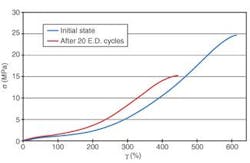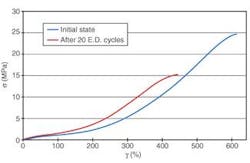Flexible riser connections adapted to testing deepwater applications
Jean-Pierre Chaumieau
Techlam
Jacques Rey
Snecma Propulsion Solide
Over the past five years, Techlam, based in Cernay, eastern France, has devel-oped a range of flexible connections for deepwater applications. Parent com- pany Snecma Moteurs is a specialist in rubber materials, which it has also adapted for offshore use. To meet increasingly stringent design specifications for deepwater projects, the two parties have jointly developed a rubber compound for use in Techlam's connectors, known as HNBR (Hydrogenated acroNytrile Butadiene Rubber).
Its first major application started in Dec-ember 2001, on the Girassol field offshore Angola, where it has been applied in flexible joints on oil export lines between the FPSO and the offloading buoy. Flexible connections with this compound are also suitable for the upper sections of steel catenary oil/gas injection/gas lift risers and test lines associated with FPSOs and semisubmersibles, and on export lines from FPSOs, TLPs, and spar platforms.
HNBR's main features are:
- Good resistance to high operating temperatures and pressures
- High strength and strain tensile properties
- Strong resistance to live oil, gas, and chemicals
- Good behavior for molding process.
Since 2002, the two companies have also undertaken R&D to develop new formulations of the material with high resistance to explosive decompression and H2S migration. The aim is to qualify a new fail-safe HNBR flexible joint concept, followed by design and testing of a full-scale prototype.
Bonding system
Techlam's flexible connections employ the laminated rubber component concept found widely in industrial applications such as anti-vibration mounts, shock absorbers, and elastic couplings. This involves bonding of multiple rubber layers to metallic or composite reinforcement shims. The rubber's low stiffness value permits a level of shear deformation under a small compression load, while the shims increase the entire component's compression stiffness.
The end product ensures a flexible connection between two rigid assemblies. This can also endure both vertical and horizontal loads, maintain fluid tightness, and withstand effects of high temperatures or aggressive fluids. Suitable deepwater applications include flexible moorings for hybrid riser systems and TLP tendon connectors.
Each layer of the laminated rubber component is subjected to compressive loads caused by tensioning of the riser or tendon, shear loads at the rubber layer edges, and further shear loads induced by displacement of the end connections or shims (caused by floater/riser interaction). The flexible connection can rotate at up to 22° in all directions, with a low torque, thereby limiting stiffness and also fatigue in the riser or tendon.
null
For safety purposes, the rubber material must sustain a minimum 400% shear at break (for a 1 MPa shear modulus) and an appropriate fatigue resistance for the operating temperature range – this varies from 4° C at the seabed up to 130° C in production risers. Risers are also prone to fast pressure drop, so the potential for explosive decompression inside the rubber must be taken into account. This can be brought on by sudden eruption of diffused gas bubbles, which leads to blistering of the rubber. Contact with drilling mud or pigging equipment may additionally cause erosion damage in the rubber.
In deepwater applications, flexible elements typically have outside diameters in the range 500 to 2,500 mm. The rubber molding process must ensure a correct temperature profile during the curing cycle, to ensure homogeneous rubber curing and bonding.
HNBR compounds have been available for 25 years. Although non-hydrogenated NBR materials have been adopted successfully for deepwater flexible connections featuring laminated rubber, HNBR increases the range of potential applications. Its higher operating temperatures are better suited to more demanding production riser requirements, and its improved physical-chemical resistance enhances the riser's service life.
Different compounds may be formulated to attain the properties best suited to the application. From a basic HNBR rubber compound, it is possible to adjust the hydrogenation rate from 90 to 99%, and the acrylonites group rate from 17 to 49%. The rate of hydrogenation is related to the chosen curing system (i.e. peroxide or sulfur), which in turn impacts ageing resistance and mechanical resistance to rupturing.
To simulate the rubber behavior in the flexible connection, Snecma Propulsion Solide developed a single shear component sample. Here a rubber layer with a shear factor close to that of the full-scale laminated rubber component is bonded between two steel shims. A lateral rubber bonded cover represents the rubber covering on the full-scale component, which protects the steel shims against corrosion. This sample can be pre-compressed during an aging test, and also sheared at break either pre- or post-aging.
Typically, the rubber configurations within a riser's flexible connection are reproduced by testing aging samples in a reactor filled with liquid and gaseous phases that match as closely as possible actual field oil and gas compositions, temperatures, and operating pressures. IFP's test facilities in France have been employed for this purpose.
Explosive decompression tests are determined by the rubber's permeability to CH4 and CO2 at given temperatures and pressures. The results are used to estimate time needed to saturate the rubber samples with gas, and to calculate pressure level durations both at the initial stage and between two decompression cycles. Some samples are sheared at break under room temperature, others at intervals of three to 30 days at varying decompression cycles or speeds.
These and other test procedures have been adopted for proven HNBR-based connections on the 16-in. Girassol export lines and for the ongoing Kizomba A development. Techlam is now adapting the HNBR compound's properties for use in a new concept, known as FSDB, for high-temperature, high-pressure production risers in deepwater. ;
Reference
Deepwater Offshore Technology Conference, Marseille, November 2003.

